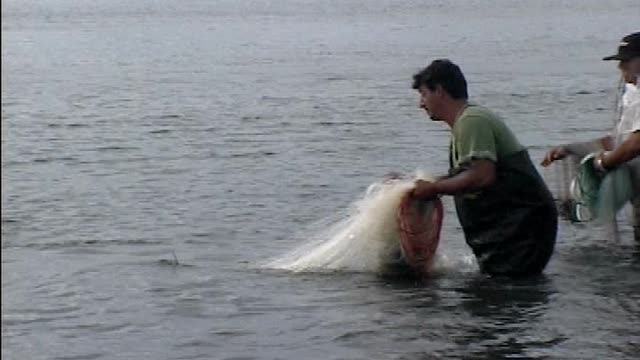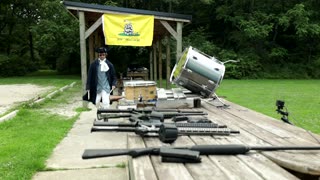Premium Only Content

Dolphin/Fishermen Cooperation in Laguna, Brazil
Bottlenose Dolphins in Laguna Requesting a Throw Net
(Supporting material for Dr. Nissani's presentation at the 2007 International Ethological Conference.)
In collaboration with colleagues Arthur Schiefler and Prof. Dr. Geraldo Milioli, I have studied what Karen Pryor refers to as "a dolphin-human fishing cooperative in Brazil (Marine Mammal Science 6:77--82). We were especially interested in this question: "Do the dolphins understand that they are giving a signal to the fishermen to cast the net, or have they acquired this unique signal through blind, mindless, years-long, trial and error learning?" We paid therefore particular attention to the fairly standardized and stereotypic signal given by these bottlenose dolphins. We do not know yet whether the dolphins understand their signaling action, but we plan to publish a detailed description and analysis of the signal itself. Until we get around to this laborious job, we decided to place some of our best signaling clips, of different dolphins, on the web. We would welcome any comments and interpretations of what is seen here (aa1674@wayne.edu). Here, anyway, is one sequence of dolphins Arreia Braço first, and then Ligerinho, taking place on November 2, 2006.
We may also note in passing that this natural wonder is under severe threat, leading to at least two applications 1. If you find yourself in the Laguna area, it's well worth a visit. It's one of the most beautiful towns in Brazil, with great surfing and wonderful people--all these besides the signaling dolphins. 2. Maybe, if just enough people realize the grave threat (from pollution, overfishing, overpopulation, motor boats . . . ) to the remnants of this natural wonder, the dolphins, and the way of life of the traditional fishermen and hobbyists, can still be saved. It's almost Earth Day, 2008, when we're posting this, so maybe humanity, Brazil, the state of Santa Catarina, the cities of Tubarão and Laguna, will still come to their senses and save this fabulous, incredibly beautiful and touching, dolphins and their odd way of sustaining themselves in a hostile world.
Nature of Signal (of the Dolphins of Laguna “Asking” Fishermen to Cast their Nets)
We have video recordings of complete, or partial, 68 signaling sequences, filmed on 11 different days, in the spring of 2006, from September 7 to November 5, in collaboration with colleagues Arthur Schiefler and Prof. Dr. Geraldo Milioli. Of these 68 signals, 54 were recorded in two adjacent, standing fishermen only, locations, on the Laguna side of the inlet. The other 14 were recorded in a more western location on the Laguna site, comprising 6-10 active standing fishermen on the eastern portion of the site joined to the west by two canoeists, all forming a single line. The sequence typically begins with the rapid surfacing of the signaling dolphin (henceforth: start of signal). Of the 45 signals for which we have a video record of first sighting a would-be signaler, in 42 the first body part observed above water was the rostrum or rostrum and head, in one episode of breaking surface, the dorsal fin was seen first, and in two others, the entire body could be observed under the water prior to breaking surface. In 53 of 55 of videorecorded cases, the surfacing was accompanied by a short, explosive, air exhalation. We were able to record the time lapse between first sighting of a signaling dolphin and visible start of exhalation in 41. In one of these cases, the exhalation started at the same time the dolphin first emerged. In the other 40, the exhalation took place after a brief delay (Mean: 0.16 seconds; range: 0.07-0.33). Signaling dolphins reach maximum elevation of their head within 0.19 seconds of first becoming visible (N=33, range, 0.1-0.5 seconds), with the head at an average angle to the water of 28.8º (N=24, range 15º-35º). The fin is typically first seen in 0.3 seconds from the start (N=39, range; 0-0.77). On average, the tip of the rostrum touches the water in 0.43s from the start of the sequence (N=33; range 0.17-0.83). The dorsal fin reaches its approximate highest position by 0.84s (N=48, range .53-1.5).
In 39 of 53 cases, the last part observed before the dolphin vanished below the surface of the water, the dorsal fin was seen last. In 8 additional cases, the tip of the dorsal fin and the midway portion of the dorsal part of the body, approximately midway between fin and fluke, were seen last at the same time. In 4 other cases, the fluke was seen last.
The average duration of any part of the body staying above water during the signaling sequence was 1.40s (N=56; range-0.93-2.50; standard deviation 0.3). Of the 68 signals, 34 were directed seaward, roughly in an eastern direction, in 7 the head was directly facing the line (North), in 8 it was directed towards the line, but at an angle (roughly north-east or north-west), in 17, the movement was towards the right, away from the sea, in a right-hand angle to the left of the line of standing fishermen or mixed fishermen/canoeists. In one case it was directly away from the fishermen (South), and in still one other case, away at an angle (roughly SW).
-
 DVR
DVR
Welcome to the Rebellion Podcast
12 hours ago $4.56 earnedHappy July 4th - WTTR Podcast Live 7/4
8.43K2 -
 10:59
10:59
The Car Guy Online
2 days agoFormer GM Engineer EXPOSES Planned Obsolescence Tactics.
23.1K17 -
 LIVE
LIVE
FyrBorne
14 hours ago🔴Warzone M&K Sniping: Salute To The Ones Who Made It Possible
24 watching -
 LIVE
LIVE
tylerpasta
4 hours agoWARZONE WRECKAGE: Pasta King Drops Hot!
28 watching -
 2:46
2:46
Gun Drummer
18 hours agoHappy Independence Day!
19.9K30 -
 22:41
22:41
Ohio State Football and Recruiting at Buckeye Huddle
1 day agoOhio State Football: 7 Things to Know about the 2025 Buckeyes
14.8K3 -
 9:30
9:30
The Art of Improvement
22 hours ago $3.97 earned5 Common Behaviours That Kill Productivity
21.8K2 -
 50:56
50:56
SinCityCrypto
22 hours ago $2.36 earnedBitcoin on a Historical Run!
16.8K8 -
 13:18
13:18
Breaking Points
1 day agoJeremy Scahill REVEALS Hamas Ceasefire Strategy
21.3K13 -
 23:28
23:28
Liz Wheeler
16 hours agoLEAKED Big Pharma Plot to Destroy RFK Jr.
21.6K14